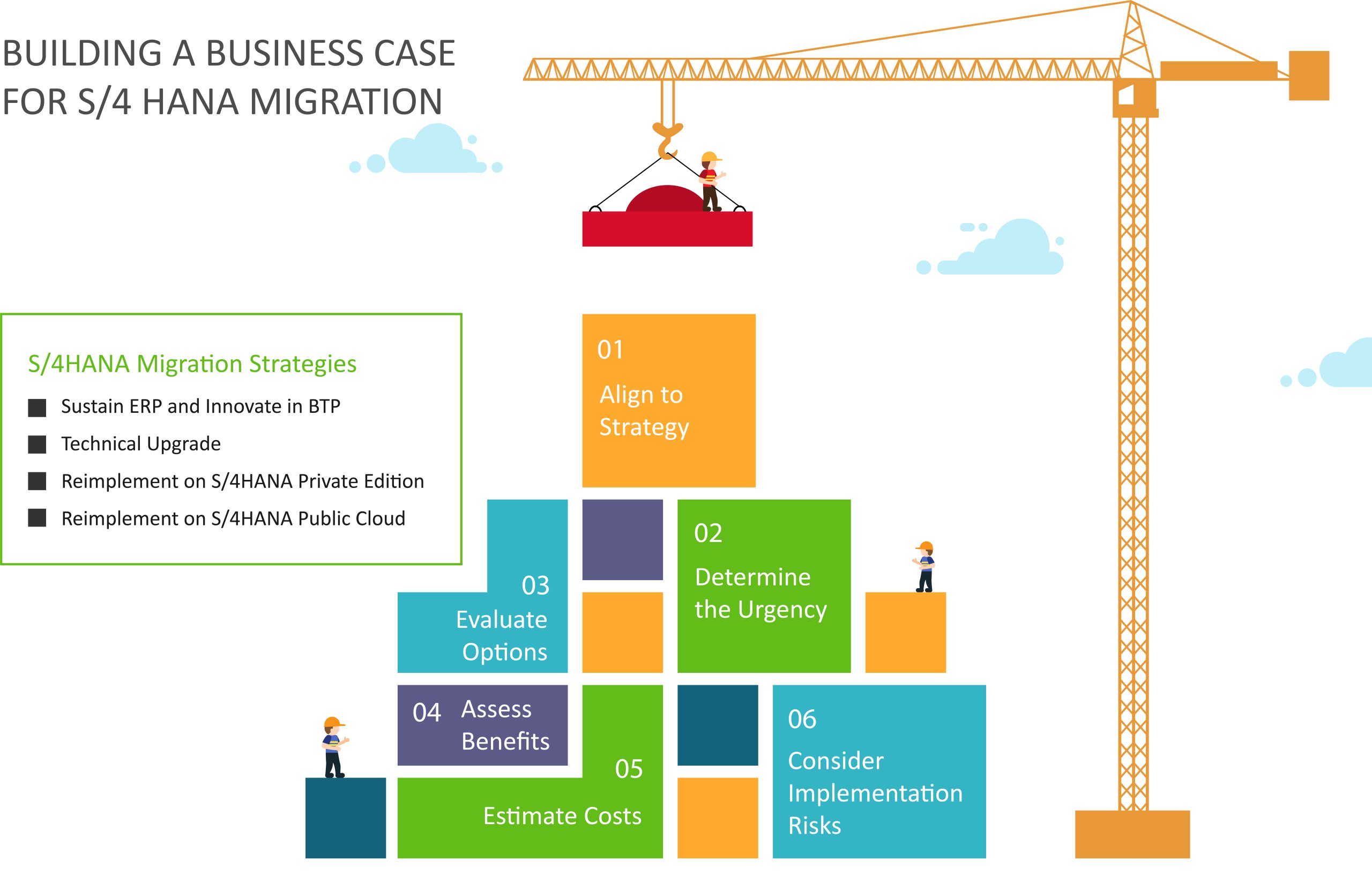The Drivers of S/4HANA Migration
Digital transformation has become an imperative in almost every industry. Beyond simply digitalization of business processes, or transition from on-premise applications to the cloud, technology advances are requiring organizations to exploit their data and intellectual property to radically improve their products and services to compete with new disruptors. Through digital collaboration across the supply chain, successful organizations will be able to predict demand sooner and provide tailoring to your SAP solution faster at a lower cost than laggards who do not rejuvenate their operating models.
Several well-established software vendors are delivering advanced business application capabilities including SAP, Microsoft, Oracle, Infor, Salesforce, and Workday. Technology platforms such as Microsoft Azure, Amazon Web Services, and Google Cloud all support in-memory computing, highly scalable and resilient infrastructure, and advanced artificial intelligence capabilities.
The business case drivers for radical technology transformation are no longer discretionary, but increasingly existential. The choice is not if, but when, and with whom, to commence this journey. This choice will be influenced less by technology comparisons, which are continuously improving and leapfrogging each other, and which in any case likely already exceed an organization’s bandwidth to fully adopt, but rather on speed of deployment, implementation cost, and trust.
The price of this technology transition will be substantial, in both direct licensing and consulting services, but also on internal resources. However, the biggest cost may be the opportunity cost of missing a once-in-a-decade opportunity to radically transform your digital platforms by conducting a technical upgrade only. A key reason for staying with SAP is to avoid the cost of a greenfield implementation. But why squander this perfect opportunity to reimagine your process flows and operating model through an S/4HANA migration?
6 Factors to Consider When Building an Effective Business Case
When building an effective business case, it is important to consider the strategic alignment, urgency, options, relative benefits, costs, and risks of the proposed initiative. Here, we will look at each success factor towards an effective business case for S/4HANA migration in further detail.

1. Align to Strategy
Every organization has a vision for what it seeks to achieve. This vision is realized through defining strategies and achieving strategic goals and objectives. Strategies must adapt quickly to changes in the operating environment. In the current unstable geo-political environment, organizations are being buffeted by a range of forces including climate change, deglobalization, inflation, and resource constraints. But it is technological advancements, including the pervasive application of artificial intelligence (AI) that are imposing the greatest challenges and opportunities for organizations in every industry.
Data quality and data management become the essential ingredient to machine learning and process optimization with AI. Consequently, for many organizations, digitalization of business processes has become an imperative strategic priority throughout selective data transition. SAP S/4HANA migration from on-premise is normally aligned with digital transformation goals and objectives.
However, if executives of an organization have not yet recognized the strategic imperative of digital transformation, it is very unlikely that the costs and effort of a successful transformation could be justified in a business case. If digitalization and transformation are not on the strategic priority list, your SAP S/4HANA migration ambition will need to be scaled back to a bare-minimum technical proposal. This will simply assess the cost of extended support compared to a technical upgrade, with limited attempt to justify the cost based on enhanced functional capabilities.
2. Determine the Urgency of S/4HANA Migration
A business case motivated by a compelling event adds urgency to the decision. There are two key drivers of urgency: the opportunity cost of delayed digital transformation, and the SAP-mandated requirement to upgrade by 2027.
Of the two, the opportunity cost of not accelerating digital transformation is likely to be the most compelling, as this could potentially by an existential threat to an organization and its competitiveness. Almost all industries, from automotive, to finance, to hospitality and retailing have witnessed the threat from digital distributors. Organizations that have actively applied the benefits of AI to their customer service, resource allocation and decision-making processes have been able to cut costs and deliver more innovative and tailored solutions.
Where digital transformation is not viewed as urgent, organizations that run SAP ECC will nevertheless be required to conduct S/4HANA migration by the end of 2027 to avoid additional support and maintenance costs. This rapidly approaching deadline will create an excess demand for scarce consulting resources, which is likely to substantially increase associated S/4HANA migration costs and risks (if preferred consultants are unavailable).
3. Evaluate Options
A good business case always evaluates alternative approaches to achieve the desired outcome.
If there is no strategic imperative for digital transformation (or more likely, if this has not yet been realized!) then your low-cost options to business-as-usual continuity will include:
- Technical upgrade through SAP S4HANA implementation
- Remain on SAP ERP for a few more years and incur higher extended maintenance support costs with SAP data services
- Remain on SAP ERP with a 3rd party support partner
- Replace SAP ERP with a more modern but lower-cost alternative
If the strategic imperative for digital transformation is acknowledged your choices become:
- Greenfields reimplementation on processes for SAP S4HANA transformation.
- SAP system conversion to an alternative application and platform provider requires SAP advanced data migration.
For the sustenance options, the key drivers are likely to be cost and risk. For the growth options, the key drivers would include the relative strategic benefits, in addition to the cost and risk of each option.
4. Assess Benefits
The potential benefits to the organization of SAP S/4HANA migration from each of the options identified can be both quantitative and qualitative and would be assessed by the executive SAP solution manager.
Qualitative benefits relate to customer service, supplier engagement, employee collaboration, business insight and decision-making effectiveness. Whilst qualitative benefits are difficult to standardize for comparing different initiatives, they are useful for considering alternative delivery options. Comparative qualitative analysis can be done by identifying the assessment criteria, and evaluation ranges, and then applying a score to each option, weighted by relative importance. Provided the scoring rubric is consistently applied to each option, a meaningful comparison can be produced.
Quantitative benefits are primarily required when the data migration is expected to produce a financial return. Attributable benefits consider the difference between inaction and action. For example, if continuation of the status-quo is expected to result in a loss of market share of x%, compared to a market share gain of y% (as a result of higher-quality and more tailored customer solutions, for example), then the net benefit is the sum of these (x% + y%) applied to your current market revenue. Cost savings, for example, the value of internal time-savings due to increased usability and process simplification, can be evaluated by applying a cost rate to this saved time.
5. Estimate Costs
It is impractical to accurately estimate the full cost of each option before conducting detailed design and producing technical specifications.
However, SAP can provide definitive software licensing costs. And there is now considerable market experience, and your consulting partner should be able to provide range-based consulting fee estimates related to each option. Your internal costs will vary considerably by option, with more change invariably requiring more technical and business end-user involvement in design and testing.
When attempting to estimate implementation costs, it quickly becomes clear that evaluating non-SAP alternatives becomes a lot harder. Whilst an SAP ERP to S/4HANA migration is a delta-assessment with a common framework of functionality, evaluating 3rd-party solutions is akin to learning a new language. Whilst core functionality is highly comparable, the terminology (and three letter acronyms!) of a non-SAP solution is naturally different, and communication with alternative suppliers inevitably harder.
Financial metrics such as Net Present Value and Payback Period should be consistently calculated under at least the following 3 scenarios: worst case, most likely, and best case. To ensure the accuracy and consistency of calculations, online business case templates such as Stratex Online can be effectively employed.
6. Consider Implementation Risks
The best option should also factor in implementation risk. Most information technology projects are subject to some degree of uncertainty, and sometimes it’s the smallest details that can consume substantial effort and cost. A multi-factored assessment of implementation risk should thus be conducted on all options, using a common evaluation framework.
A key measure of commercial risk is variability of cost. Where all three drivers of cost (license, external and external labor) are highly variable, there is a much greater risk of exceeding budget allocations. Commercial risk can also be assessed with reference to contractual terms and conditions. Engaging new business partners, for example, is riskier than continuing an existing trusted relationship. Fixed price agreements may indeed be riskier than time and material agreements when the contractual scope is not definitively specified.
Technical risk can be assessed based on familiarity with the new technology, and evidence of recent success in comparable organizations.
Change management risk is a further significant consideration. For example, the greater the change in terminology used a new solution, the greater the risk of miscommunication and resistance, distracting from the focus on important process transformations.
Should I Consider S/4Hana Migration?
Assuming that the price and capabilities of the competing solutions are roughly aligned in a competitive marketplace, the key question to consider is whether now the time is to make a switch to a different application platform. That choice will really come down to a few things:
- Data migration
- Change management
- Vendor assessment
Staying with SAP will unquestionably simplify your historical transaction and master data migration. But will the opportunity to replicate the past in your new system constrain the opportunity to restructure your business? Will the temptation to limit change outweigh the potential benefits of a fresh approach to adopting new management hierarchies, charts of account and other classifications?
S/4HANA core is remarkably similar to SAP enterprise resource planning from an end-user perspective if accessed via the traditional user-interface. Even SAP Fiori applications reflect familiar terminology and concepts. Would the change management not be greatly reduced by staying with SAP? This is true, but again it imposes a risk that necessary change is not adopted when given this excellent opportunity for radical reassessment of core processes.
The key question debated in boardrooms everywhere is whether SAP is still their business application partner of choice. And for many, this comes down to a matter of trust. Will SAP offer a fair price and committed service? Sometimes, business relationships get stale, and fresh enthusiasm can produce considerable dividends. Has your journey with SAP over the years been positive in the main, and do their corporate values and demonstrated behaviors align? And do you have any compelling evidence that your experience may be any different with another partner?
If you’re comfortable with your choice of SAP as your go-forward strategic IT partner, you still have choices with regard to your S/4HANA migration strategy.
S/4HANA Migration Strategies
Sustain ERP and Innovate in BTP
Have you considered retaining your ERP Core and complementing it with advanced Business Technology Platform services including user-interface, analytical, integration capabilities? That way, core functionality could remain untouched, and the innovation effort and budget could be focused on new capabilities. Unfortunately, SAP is requiring customers to upgrade to S/4HANA by 2027 to access standard support. Retaining your current solution will thus need to factor in additional extended maintenance support fees, or you could consider accessing an alternative support partner, such as Rimini Street.
Technical Upgrade
What about your customizations? A key feature of SAP has always been its high degree of base configurability plus the ability to greatly extend core functionality leveraging SAP’s proprietary ABAP development language. Indeed, what many long-time SAP technicians love most about SAP is the transparency of the standard underlying programming logic, and the ability to radically extend this functionality using the same programming paradigm.
With S4HANA finance, SAP is taking customers on a journey that ends with public cloud – a future state where your deep on-stack customizations are replaced by extension services hosted in the SAP S4HANA cloud. In this future true SaaS model, your core ERP is kept ‘clean’ and can be frequently and automatically updated with new features and functionality. Usability and functionality extensions are hosted on the Business Technology Platform, leveraging a range of programming languages and technical architectures. Keeping your existing customizations by doing a ‘technical’ upgrade takes you no closer to this more flexible future.
One of the key benefits of migrating customizations off SAP ECC and onto the Cloud Application Programming (CAP) model provided as part of SAP’ Business Technology Platform is to be able to access a growing talent pool. Whilst today ABAP programming support is broadly and cost-effectively available, most younger developers are choosing more modern development frameworks. And whilst the Restful ABAP Programming (RAP) model is still accessible to transitional ABAP developers, the general guidance is to expedite your transition to SAP’s CAP model as part of your S/4 migration.
Reimplement on S/4HANA Private Edition
A greenfield implementation provides an opportunity to refactor your SAP HANA organization structures (e.g. Divisions, Plants, Business Areas), master data (e.g. chart of accounts, cost center hierarchy) and business processes based on new functionality and your current operating model. Most businesses have significantly evolved over the last ten or twenty years since you first implemented SAP: has your legacy system kept up?
From the end-user perspective, new implementation of standard process flows enables you to maximize your adoption of SAP Applications built on Fiori. For example, most of the standard Fiori apps are based on planning data being read from the ACDOCP table. Whilst there are transitional reports that will populate ACDOCP from the legacy planning and budgeting tables, a fresh implementation provides an opportunity to progress directly to your target architecture, replacing annual budgets and planning versions with planning categories and updated availability control definition.
The key benefit of going to SAP S4 HANA Private Edition is that you can keep your essential customizations within the familiar ERP core as on-stack extensions. Whilst customizations should ideally be done in the BTP extensibility layer, practically this is not always possible due to API limitations. For example, if you use SAP Investment Management for S/4HANA to control budget allocation towards your capital projects, and you would like to transform this process with a Fiori user experience, you will find that there are gaps in the availability of exposed BAPIs to support the budget distribution functionality.
RISE with SAP is an innovative model whereby a collaboration of System Integration partners, SAP, and commercial hyper-scalers (including AWS, Azure, and Google Cloud Platform) provide customers with an easier to manage contractual SaaS approach for a comprehensive S/4HANA private cloud deployment.
Reimplement on S/4HANA Public Cloud
Strategically, the goal is to transition to a true SaaS ERP solution and accommodate all unique customizations in the BTP extension layer.
The key drivers for adoption of SAP public cloud edition are breadth of functionality, speed of implementation, global consistency, and elimination of future upgrade projects.
Naturally, a direct integration platform to public cloud requires the most organizational change management. Legacy processes and customizations are replaced with out-the-box process activation and users will require some support in adapting to the new functionality.
Increasingly, SAP is starting to deliver public cloud only Fiori Applications and integration features as the SAP customer is further encouraged to implement the public cloud platform to be able to compete more effectively with cloud-native solutions such as salesforce.com and Workday.
If this is where both you and SAP want to end-up, it is definitely worth a detailed assessment of the viability of a direct to public cloud migration strategy. Whilst the up-front data migration and change management costs may be higher, elimination of future upgrades should prove to be a significant cost saving over the longer term.
S/4HANA Migration is an Inevitability
Ultimately, the question is, “how much are you prepared to spend to ensure your future success in an increasingly digital world”? You will likely spend it all, plus some, so spend it wisely with partners you trust. If your journey with SAP has been positive so far, now is not the time to change partners, but to embrace change. Mitigate the risks of missing the opportunity to refactor your intelligent core by adopting a greenfield approach, ideally moving directly to Public Cloud, and deal with any once-off data migration and change management impacts this may incur.
Leave your legacy customizations behind and innovate and extend primarily to the BTP platform. Align your S/4HANA decisions with your organizational strategy and the potential to deliver increased value to your customers. Otherwise, your competitors will eventually make their own SAP S/4HANA migration. Contact us today if you would like to learn more about how IQX can leverage your S/4HANA migration to maximize your business potential, or check out one of our CapEx eBooks below.
Related Posts
If you enjoyed reading this, then please explore our other articles below:




